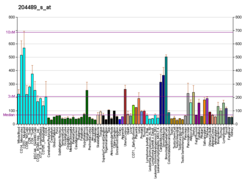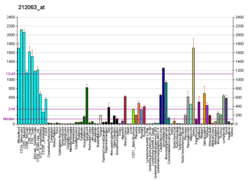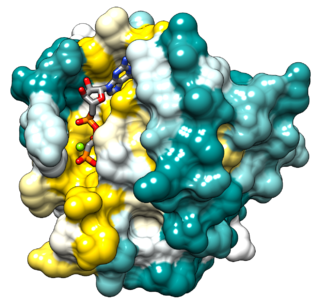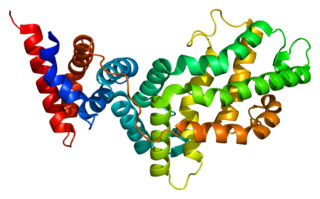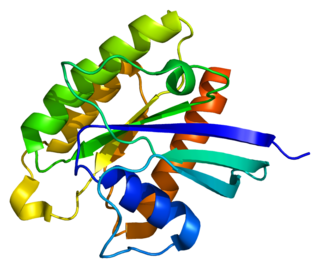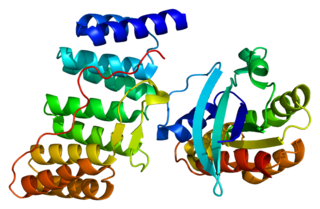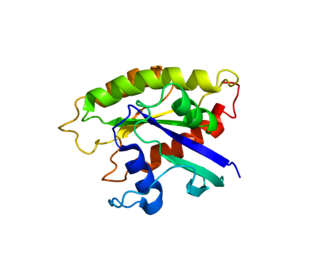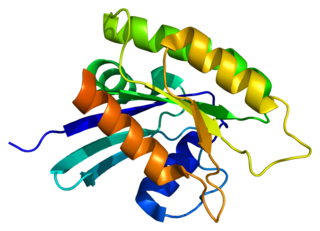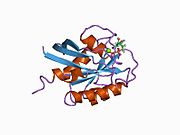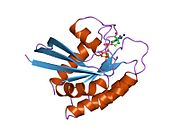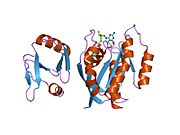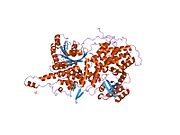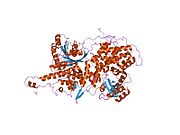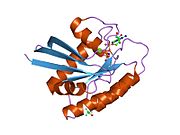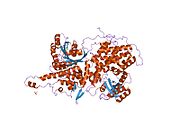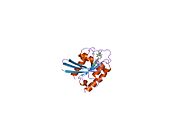121p: STRUKTUR UND GUANOSINTRIPHOSPHAT-HYDROLYSEMECHANISMUS DES C-TERMINAL VERKUERZTEN MENSCHLICHEN KREBSPROTEINS P21-H-RAS
1aa9: HUMAN C-HA-RAS(1-171)(DOT)GDP, NMR, MINIMIZED AVERAGE STRUCTURE
1agp: THREE-DIMENSIONAL STRUCTURES AND PROPERTIES OF A TRANSFORMING AND A NONTRANSFORMING GLY-12 MUTANT OF P21-H-RAS
1bkd: COMPLEX OF HUMAN H-RAS WITH HUMAN SOS-1
1clu: H-RAS COMPLEXED WITH DIAMINOBENZOPHENONE-BETA,GAMMA-IMIDO-GTP
1crp: THE SOLUTION STRUCTURE AND DYNAMICS OF RAS P21. GDP DETERMINED BY HETERONUCLEAR THREE AND FOUR DIMENSIONAL NMR SPECTROSCOPY
1crq: THE SOLUTION STRUCTURE AND DYNAMICS OF RAS P21. GDP DETERMINED BY HETERONUCLEAR THREE AND FOUR DIMENSIONAL NMR SPECTROSCOPY
1crr: THE SOLUTION STRUCTURE AND DYNAMICS OF RAS P21. GDP DETERMINED BY HETERONUCLEAR THREE AND FOUR DIMENSIONAL NMR SPECTROSCOPY
1ctq: STRUCTURE OF P21RAS IN COMPLEX WITH GPPNHP AT 100 K
1gnp: X-RAY CRYSTAL STRUCTURE ANALYSIS OF THE CATALYTIC DOMAIN OF THE ONCOGENE PRODUCT P21H-RAS COMPLEXED WITH CAGED GTP AND MANT DGPPNHP
1gnq: X-RAY CRYSTAL STRUCTURE ANALYSIS OF THE CATALYTIC DOMAIN OF THE ONCOGENE PRODUCT P21H-RAS COMPLEXED WITH CAGED GTP AND MANT DGPPNHP
1gnr: X-RAY CRYSTAL STRUCTURE ANALYSIS OF THE CATALYTIC DOMAIN OF THE ONCOGENE PRODUCT P21H-RAS COMPLEXED WITH CAGED GTP AND MANT DGPPNHP
1he8: RAS G12V - PI 3-KINASE GAMMA COMPLEX
1iaq: C-H-RAS P21 PROTEIN MUTANT WITH THR 35 REPLACED BY SER (T35S) COMPLEXED WITH GUANOSINE-5'-[B,G-IMIDO] TRIPHOSPHATE
1ioz: Crystal Structure of the C-HA-RAS Protein Prepared by the Cell-Free Synthesis
1jah: H-RAS P21 PROTEIN MUTANT G12P, COMPLEXED WITH GUANOSINE-5'-[BETA,GAMMA-METHYLENE] TRIPHOSPHATE AND MAGNESIUM
1jai: H-RAS P21 PROTEIN MUTANT G12P, COMPLEXED WITH GUANOSINE-5'-[BETA,GAMMA-METHYLENE] TRIPHOSPHATE AND MANGANESE
1k8r: Crystal structure of Ras-Bry2RBD complex
1lf0: Crystal Structure of RasA59G in the GTP-bound form
1lf5: Crystal Structure of RasA59G in the GDP-bound Form
1lfd: CRYSTAL STRUCTURE OF THE ACTIVE RAS PROTEIN COMPLEXED WITH THE RAS-INTERACTING DOMAIN OF RALGDS
1nvu: Structural evidence for feedback activation by RasGTP of the Ras-specific nucleotide exchange factor SOS
1nvv: Structural evidence for feedback activation by RasGTP of the Ras-specific nucleotide exchange factor SOS
1nvw: Structural evidence for feedback activation by RasGTP of the Ras-specific nucleotide exchange factor SOS
1nvx: Structural evidence for feedback activation by RasGTP of the Ras-specific nucleotide exchange factor SOS
1p2s: H-Ras 166 in 50% 2,2,2 triflouroethanol
1p2t: H-Ras 166 in Aqueous mother liquor, RT
1p2u: H-Ras in 50% isopropanol
1p2v: H-RAS 166 in 60 % 1,6 hexanediol
1plj: CRYSTALLOGRAPHIC STUDIES ON P21H-RAS USING SYNCHROTRON LAUE METHOD: IMPROVEMENT OF CRYSTAL QUALITY AND MONITORING OF THE GTPASE REACTION AT DIFFERENT TIME POINTS
1plk: CRYSTALLOGRAPHIC STUDIES ON P21H-RAS USING SYNCHROTRON LAUE METHOD: IMPROVEMENT OF CRYSTAL QUALITY AND MONITORING OF THE GTPASE REACTION AT DIFFERENT TIME POINTS
1pll: CRYSTALLOGRAPHIC STUDIES ON P21H-RAS USING SYNCHROTRON LAUE METHOD: IMPROVEMENT OF CRYSTAL QUALITY AND MONITORING OF THE GTPASE REACTION AT DIFFERENT TIME POINTS
1q21: CRYSTAL STRUCTURES AT 2.2 ANGSTROMS RESOLUTION OF THE CATALYTIC DOMAINS OF NORMAL RAS PROTEIN AND AN ONCOGENIC MUTANT COMPLEXED WITH GSP
1qra: STRUCTURE OF P21RAS IN COMPLEX WITH GTP AT 100 K
1rvd: H-RAS COMPLEXED WITH DIAMINOBENZOPHENONE-BETA,GAMMA-IMIDO-GTP
1wq1: RAS-RASGAP COMPLEX
1xcm: Crystal structure of the GppNHp-bound H-Ras G60A mutant
1xd2: Crystal Structure of a ternary Ras:SOS:Ras*GDP complex
1xj0: Crystal Structure of the GDP-bound form of the RasG60A mutant
1zvq: Structure of the Q61G mutant of Ras in the GDP-bound form
1zw6: Crystal Structure of the GTP-bound form of RasQ61G
221p: THREE-DIMENSIONAL STRUCTURES OF H-RAS P21 MUTANTS: MOLECULAR BASIS FOR THEIR INABILITY TO FUNCTION AS SIGNAL SWITCH MOLECULES
2c5l: STRUCTURE OF PLC EPSILON RAS ASSOCIATION DOMAIN WITH HRAS
2ce2: CRYSTAL STRUCTURE ANALYSIS OF A FLUORESCENT FORM OF H-RAS P21 IN COMPLEX WITH GDP
2cl0: CRYSTAL STRUCTURE ANALYSIS OF A FLUORESCENT FORM OF H-RAS P21 IN COMPLEX WITH GPPNHP
2cl6: CRYSTAL STRUCTURE ANALYSIS OF A FLUORESCENT FORM OF H-RAS P21 IN COMPLEX WITH S-CAGED GTP
2cl7: CRYSTAL STRUCTURE ANALYSIS OF A FLUORESCENT FORM OF H-RAS P21 IN COMPLEX WITH GTP
2clc: CRYSTAL STRUCTURE ANALYSIS OF A FLUORESCENT FORM OF H-RAS P21 IN COMPLEX WITH GTP (2)
2cld: CRYSTAL STRUCTURE ANALYSIS OF A FLUORESCENT FORM OF H-RAS P21 IN COMPLEX WITH GDP (2)
2evw: Crystal structure analysis of a fluorescent form of H-Ras p21 in complex with R-caged GTP
2q21: CRYSTAL STRUCTURES AT 2.2 ANGSTROMS RESOLUTION OF THE CATALYTIC DOMAINS OF NORMAL RAS PROTEIN AND AN ONCOGENIC MUTANT COMPLEXED WITH GSP
421p: THREE-DIMENSIONAL STRUCTURES OF H-RAS P21 MUTANTS: MOLECULAR BASIS FOR THEIR INABILITY TO FUNCTION AS SIGNAL SWITCH MOLECULES
4q21: MOLECULAR SWITCH FOR SIGNAL TRANSDUCTION: STRUCTURAL DIFFERENCES BETWEEN ACTIVE AND INACTIVE FORMS OF PROTOONCOGENIC RAS PROTEINS
521p: THREE-DIMENSIONAL STRUCTURES OF H-RAS P21 MUTANTS: MOLECULAR BASIS FOR THEIR INABILITY TO FUNCTION AS SIGNAL SWITCH MOLECULES
5p21: REFINED CRYSTAL STRUCTURE OF THE TRIPHOSPHATE CONFORMATION OF H-RAS P21 AT 1.35 ANGSTROMS RESOLUTION: IMPLICATIONS FOR THE MECHANISM OF GTP HYDROLYSIS
621p: THREE-DIMENSIONAL STRUCTURES OF H-RAS P21 MUTANTS: MOLECULAR BASIS FOR THEIR INABILITY TO FUNCTION AS SIGNAL SWITCH MOLECULES
6q21: MOLECULAR SWITCH FOR SIGNAL TRANSDUCTION: STRUCTURAL DIFFERENCES BETWEEN ACTIVE AND INACTIVE FORMS OF PROTOONCOGENIC RAS PROTEINS
721p: THREE-DIMENSIONAL STRUCTURES OF H-RAS P21 MUTANTS: MOLECULAR BASIS FOR THEIR INABILITY TO FUNCTION AS SIGNAL SWITCH MOLECULES
821p: THREE-DIMENSIONAL STRUCTURES AND PROPERTIES OF A TRANSFORMING AND A NONTRANSFORMING GLYCINE-12 MUTANT OF P21H-RAS





